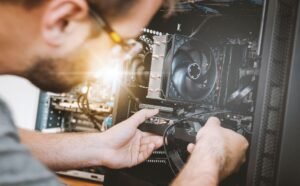Generative Music Basics
Generative music is a fascinating field that combines elements of music and technology to create unique and ever-evolving musical compositions. Unlike traditional music, which is composed and performed by humans, generative music is created by algorithms and artificial intelligence. This article will delve into the basics of generative music, how it works, and some notable examples of generative music in practice.
Key Takeaways
- Generative music is created by algorithms and artificial intelligence, resulting in unique and ever-evolving compositions.
- Generative music can be created using various techniques, such as algorithmic composition and machine learning.
- Notable examples of generative music include Brian Eno’s “Music for Airports” and Tero Parviainen’s “Bach Doodle”.
How Generative Music Works
Generative music works by utilizing algorithms to generate musical patterns, melodies, and harmonies. These algorithms can be programmed to follow specific rules or parameters, or they can use machine learning techniques to learn and evolve based on input data. The output of the algorithms is a unique and ever-changing musical composition.
One interesting aspect of generative music is that it can create compositions that are impossible for humans to conceive. *For example, generative music algorithms can generate complex and intricate melodies that would require immense musical knowledge and technical skill to produce manually.* This opens up new creative possibilities and expands the boundaries of what is considered “musical.”
Techniques Used in Generative Music
There are several techniques used in generative music, including:
- Algorithmic Composition: This technique involves using algorithms to generate musical patterns and compositions based on predefined rules or algorithms.
- Machine Learning: Machine learning algorithms can analyze and learn from large datasets of existing music, allowing them to generate new musical compositions based on patterns and styles they have learned.
- Randomization: Randomization techniques can be used to introduce unpredictability and variation into generative music compositions.
Examples of Generative Music
Generative music has been explored and utilized by various artists and musicians, resulting in some notable examples:
| Artist | Composition |
|---|---|
| Brian Eno | “Music for Airports” |
| Tero Parviainen | “Bach Doodle” |
*Brian Eno’s “Music for Airports” is a landmark example of generative music, creating an ambient and soothing atmosphere through repetitive patterns and evolving textures.* Tero Parviainen’s “Bach Doodle” uses machine learning to generate harmonies and melodies in the style of Johann Sebastian Bach, allowing users to compose their own Bach-inspired pieces.
The Future of Generative Music
Generative music continues to evolve and gain popularity, with advancements in technology and artificial intelligence pushing the boundaries of what is possible. As algorithms become more sophisticated and capable of understanding and creating complex musical structures, we can expect to see even more exciting and innovative generative music compositions in the future.
Generative music offers a unique blend of technology and creativity, expanding the possibilities of musical composition and challenging traditional notions of authorship. Whether you’re a musician, a music lover, or simply curious about the intersection of technology and art, exploring the world of generative music can be a fascinating journey.
Data Table 1: Comparison of Generative Music Techniques
| Technique | Description |
|---|---|
| Algorithmic Composition | Generates music based on predefined rules or algorithms. |
| Machine Learning | Uses machine learning algorithms to generate music based on learned patterns from existing music. |
| Randomization | Introduces unpredictability and variation into generative music compositions. |
Data Table 2: Examples of Generative Music
| Artist | Composition |
|---|---|
| Brian Eno | “Music for Airports” |
| Tero Parviainen | “Bach Doodle” |
Data Table 3: Advancements in Generative Music
| Advancement | Description |
|---|---|
| Improved AI Algorithms | Advancements in AI algorithms allow for more complex and sophisticated generative music compositions. |
| Integration with Music Production Tools | Generative music techniques are being integrated into popular music production software, making it easier for musicians to incorporate generative elements into their compositions. |
| Interactive and Collaborative Approaches | Generative music is being explored as a tool for interactive and collaborative music-making experiences, allowing users to actively participate in the creative process. |
Generative music offers a world of endless possibilities, where algorithms and technology come together to create unique and evolving compositions. With its ability to push the boundaries of musical creativity, generative music is poised to shape the future of music composition and listening experiences.

Common Misconceptions
Generative Music Basics
There are several common misconceptions surrounding the topic of generative music. These misconceptions often stem from a lack of understanding or a limited exposure to this form of music composition. By debunking these misconceptions, one can gain a clearer understanding of the basics of generative music.
- Generative music is purely random: Many people mistakenly believe that generative music is completely random and lacks any intentional design. In reality, generative music is created through a set of predefined rules and algorithms, allowing for a structured and purposeful composition.
- Generative music lacks creativity: Some may argue that creating generative music is merely a process of setting up algorithms and letting the computer generate the music. However, generative music requires a great deal of creative input from the composer in terms of designing the rules and establishing the parameters for the composition.
- Generative music is impersonal: Another common misconception is that generative music lacks emotion or personal connection. While generative music may not be directly tied to personal experiences or emotions, it can still evoke powerful emotions and provide unique listening experiences for the audience.
Generative music is often associated with randomness and lack of structure, but this is not entirely accurate. By understanding and acknowledging the misconceptions surrounding generative music, one can appreciate the complexity and creativity that goes into its composition.
- Generative music is created without human intervention: While generative music does rely on algorithms and predefined rules, it is ultimately created by a human composer who sets up these parameters. The human touch is vital in designing the creative framework for the generative system.
- Generative music is only for experimental genres: Some may assume that generative music is limited to experimental or avant-garde genres. However, generative approaches can be applied to various musical genres, including classical, jazz, electronic, and more, offering new and innovative possibilities for composition and performance.
- Generative music lacks control: Contrary to popular belief, generative music is not completely out of the composer’s control. While the actual music output may be unpredictable to some extent, the composer has the ability to adjust the parameters and rules guiding the generative process, enabling a certain level of control and influence over the composition.
By dispelling these misconceptions, it becomes evident that generative music is a carefully crafted and thoughtful approach to music composition, which can be applied to a wide range of musical genres. Generative music may not fit the traditional image of music creation, but it offers a unique and fascinating method to create beautiful and innovative musical pieces.

Generative music is a fascinating field that explores the creation of music through algorithmic or random processes. It allows for the production of unique and ever-evolving compositions, often with surprising results. In this article, we will delve into ten different aspects of generative music, showcasing interesting data and details through tables.
H2: Notable Artists and Their Works
In this table, we highlight some prominent artists in the field of generative music and provide examples of their notable works. Each artist brings a unique approach to creating music through algorithmic processes, resulting in captivating compositions.
| Artist Name | Notable Work |
|—————–|——————————|
| Brian Eno | “Music for Airports” |
| Aphex Twin | “Selected Ambient Works” |
| Alva Noto | “Xerrox Vol. 3” |
| Holly Herndon | “PROTO” |
| Ryoji Ikeda | “dataplex” |
| Autechre | “Tri Repetae” |
| Steve Reich | “It’s Gonna Rain” |
| Laurie Spiegel | “The Expanding Universe” |
| Markus Reuter | “The Longest In Terms Of Being” |
| William Basinski | “The Disintegration Loops” |
H2: Generative Music Methods
This table illustrates various methods used in generative music creation. From stochastic processes to algorithmic composition, each method offers a unique way of generating musical material, creating an immersive and ever-changing listening experience.
| Method | Description |
|——————————|————————————————————-|
| Markov Chains | Probability-based model that generates musical patterns |
| Fractal Composition | Using mathematical algorithms to create self-similar music |
| Cellular Automaton | Applied rules to grid-like structures that generate music |
| Genetic Programming | Evolving music through simulated evolution |
| Chaos Theory | Utilizes chaotic systems to generate complex musical patterns|
| Swarm Intelligence | Collective behavior of algorithms generates collaborative music |
| Algorithmic Composition | Sequential approach using rule-based procedures |
| Data Sonification | Converting data into sound to create music |
| Granular Synthesis | Manipulates tiny sound grains to generate musical textures |
| Neural Networks and AI | Machine-learning systems trained to generate music |
H2: Notable Generative Music Apps
With technological advancements, generative music has become accessible through various applications. This table showcases popular apps that enable users to create their own generative music compositions, fostering personal exploration and creativity.
| App Name | Features |
|——————-|——————————————————|
| Koala Sampler | Creating music with sampled and synthesized sounds |
| Endlesss | Collaborative generative music-making platform |
| Bloom | Generating ambient melodies through touch interaction |
| Nodebeat | Creating music through networked routing of nodes |
| Otomata | Simple generative sequencer with playful interface |
| Scape | Combination of sound samples to create evolving music |
| Mixtikl | Algorithmic music generator with extensive controls |
| Fugue Machine | Polyphonic music sequencer with generative capabilities |
| Samplr | Sampling and sequencing with generative features |
| Noatikl | Interconnected generative MIDI music engine |
H2: Benefits of Generative Music
This table highlights the benefits and advantages of incorporating generative music into various creative and everyday pursuits. From enhancing focus and productivity to fostering relaxation and creativity, generative music has a broad range of positive effects.
| Benefit | Description |
|——————|—————————————————————————————|
| Enhanced Focus | Creating an immersive sonic environment that improves concentration |
| Increased Productivity | Background generative music can boost efficiency and workflow |
| Stress Reduction | Calming and relaxing compositions help alleviate stress and anxiety |
| Creative Inspiration | Unique and ever-evolving music can spark new ideas and inspiration |
| Ambient Soundscapes | Generative music can create soothing and atmospheric backgrounds for various activities |
| Therapeutic Applications | Used in therapy to aid relaxation, meditation, and emotional well-being |
| Exploration of Musical Ideas | Provides a platform for experimenting with new sounds and structures |
| Endless Variation | The ever-changing nature of generative music ensures a constant stream of new experiences |
| Personalized Listening | Tailored compositions allow for customized musical journeys and preferences |
| A Unique Listening Experience | Generative music offers an unconventional auditory adventure |
H2: Instruments Used in Generative Music
In generative music production, an array of unique and traditional instruments are employed to craft diverse soundscapes. This table showcases some of the instruments commonly used in generative music creation.
| Instrument | Description |
|——————|—————————————————|
| Modular Synthesizer | Customizable sound modules connected via patch cables |
| Max/MSP | Visual programming environment for interactive audio |
| Tape Loops | Magnetic tape loops manipulated in real-time |
| Granular Sampler | Breaks audio into small grains for manipulation |
| Reaktor | Synthesizer and sound design software |
| Prepared Piano | Piano altered by placing objects on strings |
| Ambient Guitar | Utilizes guitar effects and delays for atmospheric sounds |
| Buchla Music Easel | Semi-modular analog synthesizer and sequencer |
| iPad Apps | Touchscreen apps with a vast range of generative music tools |
| Field Recordings | Capturing sounds from the environment to integrate into compositions |
H2: Common Generative Music Techniques
This table showcases common techniques employed within the realm of generative music. From the use of randomization to algorithmic patterns, these techniques contribute to the organic and evolving nature of generative compositions.
| Technique | Description |
|——————–|————————————————————|
| Randomization | Injecting randomness into musical parameters |
| Feedback Loops | Creating self-perpetuating patterns and variations |
| Chance Operations | Employing probability-based decision-making in composition |
| Algorithmic Patterns | Applying rule-based algorithms to generate musical material |
| Mutable Instruments | Using instruments with modifiable parameters and functions |
| Repetition | Repeating musical patterns and motifs |
| Parameter Mapping | Mapping different musical parameters to interplay with each other |
| Generative Sampling | Generating new musical material by manipulating sampled sounds |
| Interplay of Layers| Layering different generative elements for a complex texture |
| Dynamic Systems | Using dynamic models to evolve the musical composition |
H2: Famous Generative Music Installations
Generative music extends beyond traditional music production, often evolving into immersive installations. This table presents well-known generative music installations that have captivated audiences through their interactive and evolving sonic experiences.
| Installation Name | Description |
|—————————|————————————————————|
| “The Harmonic Bridge” | A bridge where visitors’ movements generate harmonious sounds |
| “Rain Room” | Interactive sound installation that responds to rain patterns |
| “Bloom” | Spherical speakers emitting evolving music and lights |
| “Scapes” | Generative music experience created by Brian Eno and Peter Chilvers |
| “Ragpicker’s Dream” | An installation where music is generated from recycled objects |
| “Living Planet” | Interactive exhibit translating data into generative music |
| “Wave Interference” | Visitors use their movements to generate sound waves |
| “Waterlicht” | Light and sound installation simulating a virtual flood |
| “Universe of Water Particles” | Water droplets converted into visual and audio experience |
| “Sonoria” | Immersive generative music environment within a cube |
H2: Notable Generative Music Albums
This table showcases notable albums entirely composed in the realm of generative music. Each album explores different approaches to generative music production, resulting in distinct and captivating listening experiences.
| Album Name | Artist |
|—————————–|————————|
| “Generative Music 1” | Brian Eno |
| “Vrioon” | Alva Noto & Ryuichi Sakamoto |
| “Music for Installations” | Brian Eno |
| “The Disintegration Loops” | William Basinski |
| “Selected Ambient Works Vol. II” | Aphex Twin |
| “KIMA: Vibrate Higher” | Holly Herndon |
| “Tri Repetae” | Autechre |
| “From Filthy Tongue of Gods and Griots” | Dalek |
| “Colundi Sequence Vol. 1” | Aleksi Perälä |
| “The Expanding Universe” | Laurie Spiegel |
H2: Generative Music in Film and Video Games
Apart from standalone music compositions, generative music techniques have found their way into film scores and video games, creating immersive and reactive soundscapes. This table sheds light on notable films and video games that incorporate generative music elements.
| Film/Game Name | Composer |
|——————————–|———————————-|
| “Koyaanisqatsi” | Philip Glass |
| “Interstellar” | Hans Zimmer |
| “No Man’s Sky” | 65daysofstatic |
| “Myst” | Robyn Miller & Sam Losen |
| “Journey” | Austin Wintory |
| “Blade Runner 2049” | Hans Zimmer & Benjamin Wallfisch |
| “Flower” | Vincent Diamante |
| “Fez” | Disasterpeace |
| “Sonic Pi” | Sam Aaron |
| “Proteus” | David Kanaga |
Conclusion:
Generative music offers a unique and captivating approach to music creation, showcasing the boundless possibilities technology and algorithmic processes provide. From notable artists and their works to various methods, techniques, and installations, the realm of generative music invites exploration, creativity, and an ever-evolving listening experience. Whether through standalone compositions, film scores, or video game soundtracks, generative music enriches our sonic landscape and immerses us in a world of endless musical possibility.
Frequently Asked Questions
What is generative music?
Generative music is a form of music that is created by a system or algorithm that generates the music continuously, often without the need for human intervention. It is considered to be a way of creating music that is unpredictable and ever-evolving, as the system constantly generates new melodies, rhythms, and harmonies.
How does generative music work?
Generative music works by utilizing various algorithms, rules, or parameters to generate musical elements such as melodies, rhythms, and harmonies. These algorithms can be based on randomness, mathematical formulas, or the analysis and manipulation of existing musical material. The resulting music is often unique and distinct from what a human composer might create.
What are the benefits of generative music?
Generative music offers several benefits, including the ability to create music that is constantly evolving and changing. It can also serve as a source of inspiration for musicians and composers, as it can generate unexpected musical ideas. Additionally, generative music can provide a continuous stream of music for various applications, such as background music for films, video games, and interactive installations.
What are some popular tools and software for creating generative music?
There are several popular tools and software available for creating generative music, including MAX/MSP, Pure Data, Supercollider, and TidalCycles. These tools offer various features and capabilities for generating and manipulating musical elements, allowing composers and musicians to experiment and explore different possibilities within the realm of generative music.
Can generative music be used for live performances?
Yes, generative music can be used for live performances. It can be performed by musicians who interact with the generative system in real-time, manipulating the parameters or responding to the music generated by the system. This creates a dynamic and ever-changing musical experience for the audience.
How can I start creating generative music?
To start creating generative music, you can begin by learning and experimenting with the various tools and software available for generative music composition, such as MAX/MSP or TidalCycles. Familiarize yourself with the basic concepts and techniques of generative music and explore different algorithms and rules that can be used to generate musical elements. Experimentation and exploration are key in the creation of generative music.
Are there any legal considerations when using generative music in commercial projects?
When using generative music in commercial projects, it is important to consider the legal implications and ensure that you have the necessary rights to use the music. If you are using pre-existing musical material in your generative system, make sure you have the appropriate licenses or permissions to use that material. Additionally, if you are using generative music created by others, you should obtain the necessary rights or permissions to use that music in your commercial projects.
Can generative music be copyrighted?
Yes, generative music can be copyrighted. As long as the generative music meets the requirements for copyright protection, such as originality and fixation in a tangible form, it can be protected by copyright laws. However, it is important to note that copyright protection may apply to the specific generated instances of the music rather than the underlying algorithm or system itself.
Is generative music limited to electronic music genres?
No, generative music is not limited to electronic music genres. While electronic music has often been associated with generative music due to its compatibility with digital tools and software, generative music can be applied to any genre or style of music. It can be used to generate melodies, rhythms, and harmonies in various musical genres, including classical, jazz, rock, and more.
Can generative music be considered as a form of artificial intelligence?
No, generative music should not be considered as a form of artificial intelligence (AI). While generative music systems may utilize algorithms or computational logic, they do not possess the intelligence or consciousness associated with AI. Generative music is a computer-based process that creates music based on predetermined rules or parameters, rather than making autonomous decisions or learning from experience like AI systems.




